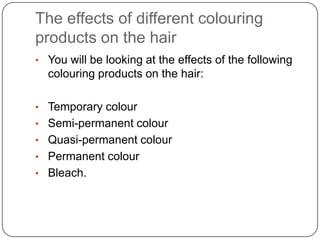The effects of different colouring products week2
- 1. The effects of different colouring products on the hair ? You will be looking at the effects of the following colouring products on the hair: ? Temporary colour ? Semi-permanent colour ? Quasi-permanent colour ? Permanent colour ? Bleach.
- 2. The effects of temporary colour ? Large colour molecules coat the hair cuticle. ? There is no penetration of the hair cortex. ? The colour will last for only 1 or 2 washes.
- 3. The effects of semi-permanent colour ? Small colour molecules are deposited into the hair cuticle and the outer edge of the hair cortex. ? The colour will last for between 6 to 8 washes. ? If the hair is unevenly porous, the result may be patchy.
- 4. The effects of quasi-permanent colour ? The quasi-permanent colour is mixed with a low-volume oxidant (1:2 ratio). ? Different sized colour molecules enter the cortex and are oxidized by the oxidant. ? Because the oxidant is mild, the colour molecules do not become very large and are gradually lost each time the hair is shampooed. ? The colour is designed to fade over a period of 12 weeks.
- 5. The effects of permanent colour ¨C stage 1 ? The permanent colour is mixed with hydrogen peroxide. small ? The strength of colourless hydrogen peroxide molecules used varies mixed with oxidant depending on the penetrate desired result the cuticle, (10, 20, 30 or 40 into the cortex volume). ? When mixed with hydrogen peroxide, the small colourless molecules penetrate the hair cuticle and the hair
- 6. The effects of permanent colour ¨C stage 2 ? The hydrogen peroxide begins to break down small into water and oxygen. colourles s ? The oxygen from the molecule hydrogen peroxide joins s mixed together with and with oxidises the small oxidant colourless molecules. penetrate ? The oxidised molecules the swell to form cuticle, in large, colour molecules. to the cortex small ? The large colour molecule molecules are unable to s swell pass back through the and hair cuticle and become become trapped within the hair larger cortex. due to the nascent oxygen
- 7. The hair before bleaching ? Bleaching is the process of Hair prior to bleach changing the natural colour application pigments in the hair so they become colourless. Natural colour pigment. ? The natural hair pigments are melanin and pheomelanin. ? Melanin pigments are black and brown. ? Pheomelanin pigments are red and yellow.
- 8. The hair after bleaching The bleach penetrates Hair after bleaching the hair cortex and oxidises the natural colour pigment so that itColourless, becomes colourless. oxymelanin For example, brown melanin pigments are changed to colourless oxymelanin.







